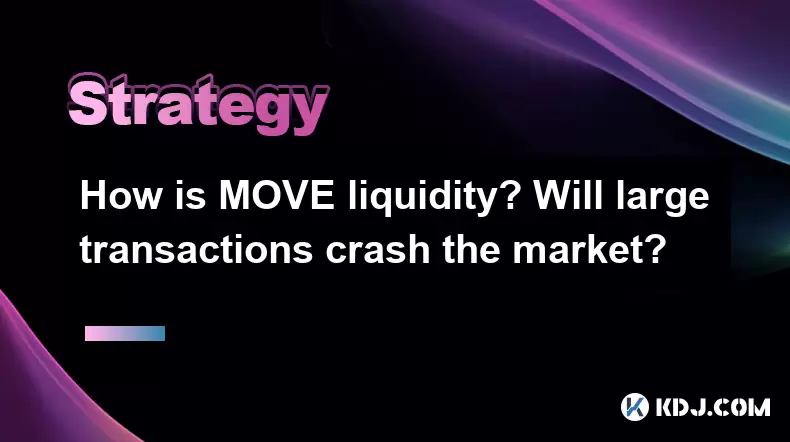-
 bitcoin
bitcoin $122090.672462 USD
1.59% -
 ethereum
ethereum $4493.758974 USD
0.56% -
 xrp
xrp $3.033145 USD
0.65% -
 tether
tether $1.000629 USD
0.00% -
 bnb
bnb $1169.854250 USD
7.07% -
 solana
solana $230.954786 USD
-0.19% -
 usd-coin
usd-coin $0.999785 USD
0.00% -
 dogecoin
dogecoin $0.256108 USD
-1.12% -
 tron
tron $0.342333 USD
-0.12% -
 cardano
cardano $0.859632 USD
-0.10% -
 hyperliquid
hyperliquid $48.932146 USD
-2.25% -
 chainlink
chainlink $22.345466 USD
-1.29% -
 ethena-usde
ethena-usde $1.000217 USD
-0.03% -
 avalanche
avalanche $31.203456 USD
1.93% -
 sui
sui $3.579145 USD
1.05%
How is MOVE liquidity? Will large transactions crash the market?
MOVE's liquidity is assessed by trading volume and order book depth; large transactions may impact the market, but strategies like limit orders can mitigate effects.
May 20, 2025 at 02:42 pm

Liquidity is a critical aspect of any cryptocurrency, and MOVE is no exception. Liquidity refers to the ease with which an asset can be bought or sold in the market without affecting its price significantly. In the context of MOVE, understanding its liquidity involves examining various factors such as trading volume, market depth, and the presence of liquidity providers. Additionally, it's important to consider the potential impact of large transactions on the market.
Understanding MOVE Liquidity
Liquidity in the cryptocurrency market is primarily measured by two key indicators: trading volume and order book depth. Trading volume represents the total amount of MOVE tokens traded within a specific period, typically 24 hours. A higher trading volume generally indicates better liquidity, as it suggests more market participants are actively buying and selling the token. On the other hand, order book depth refers to the number of buy and sell orders at various price levels. A deeper order book indicates a higher number of orders, which can absorb large trades without causing significant price fluctuations.
Factors Affecting MOVE Liquidity
Several factors can influence the liquidity of MOVE. Market sentiment plays a crucial role, as positive sentiment can attract more traders and increase trading volume. Conversely, negative sentiment can lead to decreased trading activity. Exchange listings also impact liquidity; the more exchanges that list MOVE, the more accessible it becomes to a broader audience, potentially increasing liquidity. Additionally, liquidity providers such as market makers can significantly enhance liquidity by continuously providing buy and sell orders, ensuring a smoother trading experience.
Assessing Current MOVE Liquidity
To assess the current liquidity of MOVE, one can look at various metrics available on cryptocurrency tracking websites. Trading volume can be checked on platforms like CoinMarketCap or CoinGecko, where daily, weekly, and monthly volumes are displayed. For example, if MOVE has a daily trading volume of millions of dollars, it suggests a relatively liquid market. Order book depth can be observed directly on trading platforms where MOVE is listed. A robust order book with numerous orders at various price levels indicates good liquidity.
Impact of Large Transactions on MOVE Market
Large transactions, often referred to as whale transactions, can indeed impact the market, especially if the liquidity is not deep enough to absorb these trades. When a large buy order is placed, it can drive up the price if there are not enough sell orders to match it, leading to a temporary price surge. Conversely, a large sell order can cause a price drop if there are insufficient buy orders to absorb it. The extent of this impact depends on the current liquidity of MOVE.
Mitigating the Impact of Large Transactions
To mitigate the potential impact of large transactions on MOVE, several strategies can be employed. Using limit orders instead of market orders can help manage the price impact. A limit order allows traders to specify the price at which they are willing to buy or sell, potentially reducing the immediate impact on the market. Splitting large orders into smaller, more manageable chunks can also minimize the effect on the market price. Additionally, trading on exchanges with higher liquidity can provide a buffer against large transactions, as these platforms typically have deeper order books.
Tools and Resources for Monitoring MOVE Liquidity
There are several tools and resources available for monitoring MOVE liquidity. TradingView offers detailed charts and real-time data on trading volume and order book depth. CoinMarketCap and CoinGecko provide comprehensive data on trading volume across multiple exchanges. Additionally, some exchanges offer their own liquidity metrics and tools, such as Binance's Liquidity Pool and Huobi's Market Depth Indicator. These resources can help traders make informed decisions based on the current state of MOVE liquidity.
Case Studies: Examples of Large Transactions on MOVE
Examining past instances where large transactions occurred on MOVE can provide valuable insights into how the market reacts. For example, if a whale sold a significant amount of MOVE tokens on a particular exchange, it would be useful to analyze the price movement before, during, and after the transaction. By studying these case studies, traders can better understand the potential impact of large transactions and adjust their strategies accordingly.
Strategies for Trading MOVE in a Liquid Market
When trading in a liquid market like MOVE, certain strategies can maximize potential returns while minimizing risks. Dollar-cost averaging (DCA) involves spreading out the purchase of MOVE over time, reducing the impact of volatility. Swing trading can be effective in a liquid market, as it involves taking advantage of short-term price movements. Additionally, using stop-loss orders can help manage risk by automatically selling MOVE if the price falls below a certain threshold.
The Role of Decentralized Exchanges (DEXs) in MOVE Liquidity
Decentralized exchanges (DEXs) play a significant role in the overall liquidity of MOVE. DEXs like Uniswap and SushiSwap allow for peer-to-peer trading without the need for intermediaries, potentially increasing liquidity by attracting users who prefer decentralized platforms. Liquidity pools on DEXs, where users can contribute tokens to facilitate trading, further enhance the liquidity of MOVE. However, it's important to note that DEXs can also be more susceptible to large transactions due to their often shallower order books compared to centralized exchanges.
Frequently Asked Questions:
- How can I check the real-time liquidity of MOVE?
To check the real-time liquidity of MOVE, you can use tools like TradingView for detailed charts and real-time data on trading volume and order book depth. Additionally, platforms like CoinMarketCap and CoinGecko provide up-to-date information on trading volume across multiple exchanges.
- What are the risks associated with trading MOVE on decentralized exchanges?
Trading MOVE on decentralized exchanges (DEXs) can be riskier due to potentially lower liquidity and shallower order books. Large transactions can have a more significant impact on price, and there's a higher risk of impermanent loss if you're participating in liquidity pools.
- Can liquidity providers influence the price of MOVE?
Yes, liquidity providers can influence the price of MOVE by continuously providing buy and sell orders. Their presence can stabilize the market and reduce the impact of large transactions, but they can also affect the price if they adjust their orders significantly.
- How does the liquidity of MOVE compare to other cryptocurrencies?
The liquidity of MOVE can be compared to other cryptocurrencies by examining trading volume and order book depth on platforms like CoinMarketCap and CoinGecko. Generally, more established cryptocurrencies like Bitcoin and Ethereum tend to have higher liquidity, but MOVE's liquidity can vary based on market sentiment and exchange listings.
Disclaimer:info@kdj.com
The information provided is not trading advice. kdj.com does not assume any responsibility for any investments made based on the information provided in this article. Cryptocurrencies are highly volatile and it is highly recommended that you invest with caution after thorough research!
If you believe that the content used on this website infringes your copyright, please contact us immediately (info@kdj.com) and we will delete it promptly.
- BlockDAG, DOGE, HYPE Sponsorship: Crypto Trends Shaping 2025
- 2025-10-01 00:25:13
- Deutsche Börse and Circle: A StableCoin Adoption Powerhouse in Europe
- 2025-10-01 00:25:13
- BlockDAG's Presale Buzz: Is It the Crypto to Watch in October 2025?
- 2025-10-01 00:30:13
- Bitcoin, Crypto, and IQ: When Genius Meets Digital Gold?
- 2025-10-01 00:30:13
- Stablecoins, American Innovation, and Wallet Tokens: The Next Frontier
- 2025-10-01 00:35:12
- NBU, Coins, and Crypto in Ukraine: A New Yorker's Take
- 2025-10-01 00:45:14
Related knowledge

Practical parameter settings for a Bitcoin multi-timeframe moving average system
Sep 18,2025 at 10:54pm
Optimizing Timeframe Combinations for Bitcoin Trading1. Selecting appropriate timeframes is crucial when building a multi-timeframe moving average sys...

How can I filter out false breakouts in Dogecoin high-frequency trading?
Sep 22,2025 at 01:00am
Understanding False Breakouts in Dogecoin Trading1. A false breakout occurs when Dogecoin's price appears to move beyond a defined support or resistan...

Techniques for identifying tops and bottoms in the Bitcoin on-chain NVT model
Sep 20,2025 at 07:54pm
Understanding the NVT Model in Bitcoin Analysis1. The Network Value to Transactions (NVT) ratio is often described as the 'P/E ratio' of the cryptocur...

What does the surge in open interest in Bitcoincoin futures mean?
Sep 20,2025 at 11:18pm
Understanding the Surge in Dogecoin Futures Open Interest1. A surge in open interest within Dogecoin futures indicates a growing number of active cont...

How can I use the Ethereum USDT premium to gauge market sentiment?
Sep 18,2025 at 11:55pm
Understanding the Ethereum USDT Premium1. The Ethereum USDT premium refers to the price difference between USDT (Tether) traded on Ethereum-based plat...

What should I do if Ethereum staking yields decline?
Sep 20,2025 at 06:18am
Understanding the Causes Behind Declining Ethereum Staking Yields1. The Ethereum network transitioned to a proof-of-stake consensus mechanism with the...

Practical parameter settings for a Bitcoin multi-timeframe moving average system
Sep 18,2025 at 10:54pm
Optimizing Timeframe Combinations for Bitcoin Trading1. Selecting appropriate timeframes is crucial when building a multi-timeframe moving average sys...

How can I filter out false breakouts in Dogecoin high-frequency trading?
Sep 22,2025 at 01:00am
Understanding False Breakouts in Dogecoin Trading1. A false breakout occurs when Dogecoin's price appears to move beyond a defined support or resistan...

Techniques for identifying tops and bottoms in the Bitcoin on-chain NVT model
Sep 20,2025 at 07:54pm
Understanding the NVT Model in Bitcoin Analysis1. The Network Value to Transactions (NVT) ratio is often described as the 'P/E ratio' of the cryptocur...

What does the surge in open interest in Bitcoincoin futures mean?
Sep 20,2025 at 11:18pm
Understanding the Surge in Dogecoin Futures Open Interest1. A surge in open interest within Dogecoin futures indicates a growing number of active cont...

How can I use the Ethereum USDT premium to gauge market sentiment?
Sep 18,2025 at 11:55pm
Understanding the Ethereum USDT Premium1. The Ethereum USDT premium refers to the price difference between USDT (Tether) traded on Ethereum-based plat...

What should I do if Ethereum staking yields decline?
Sep 20,2025 at 06:18am
Understanding the Causes Behind Declining Ethereum Staking Yields1. The Ethereum network transitioned to a proof-of-stake consensus mechanism with the...
See all articles










































































